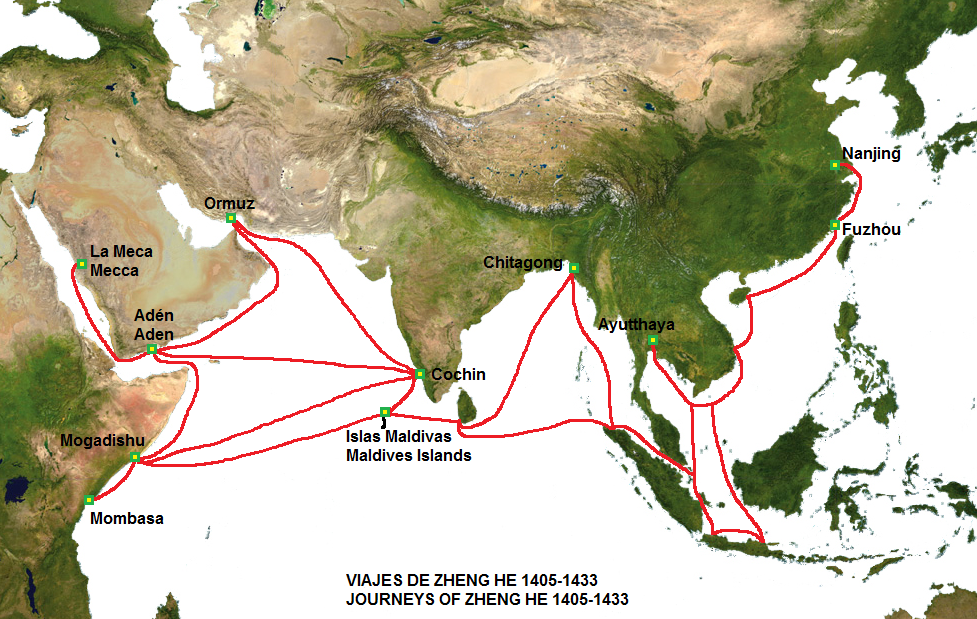Fantasy masquerading as history
Between 1405 and 1433, during the Ming Dynasty, the Chinese eunuch admiral Zheng He (also known as Cheng Ho) led a large fleet on seven voyages to South-East Asia, India, Arabia, and the African coast, to extend Chinese influence in the area. They dispensed and received gifts, made diplomatic contacts, brought back to ostriches, camels, zebras and a giraffe, and defeated notorious pirates. By the end of his final voyage, state policy had changed. Travel abroad was now discouraged, and China turned in upon herself.
Some years ago I came across a book by Gavin Menzies called 1421: The Year China Discovered the World, an account of how Zheng He’s voyages were more far reaching than had previously been thought. I finally got round to reading on board the sailing vessel Europa, on a voyage from the Azores to Amsterdam, where the book was in the ship’s library.
The author described how his research, along with personal insights from his time in the Royal Navy, had led him to conclude that Zheng He and his ships had, in the course of their voyages, worked out a way to calculate longitude, visited Australia and New Zealand, North and South America, sailed round Cape Horn, circumnavigated the globe, and even landed in Antarctica, leaving behind traces of their visits, as well as settlers from whom some indigenous populations were said to be descended. This was pretty incredible stuff. It was an interesting story, although there did seem to be a lot of conjecture as well.
When I got back to England and to internet access, I thought I’d look into this a little more. It turned out that Menzies had attracted quite a lot of attention from academics in the field. His claims have been refuted in exhaustive detail, collated in the website www.1421exposed.com .
Map showing the supposed voyages of the Ming fleet, according to Menzies
There are, it would appear, no records of any Ming Dynasty voyages beyond Asia, the Middle East or the East coast of Africa. Menzies describes various wrecks, as well as structures constructed by the Chinese visitors all over the world. None of these have ever been found. He claims that the Venetian, Nicolò da Conti, travelled with the Chinese fleet, and brought Chinese maps back to Europe, which were used by the Portuguese when they set out on their voyages of discovery. Yet da Conti, who left copious accounts of his travels, mentions none of this. And so on.
The whole business reminds me of Erich von Däniken who wrote a whole series of books, starting with Chariots of the Gods?, in which he claimed that aliens from outer space had visited Earth and influenced early human culture. He believed that structures like Stonehenge and the Easter Island statues could not have been built by humans at the time without assistance from more technologically advanced civilisation, i.e. his extra-terrestrial visitors. I read a couple of his books in the 1970s as a teenager, and I remember they were quite popular at that time. Not that I believed him for a minute. Perish the thought.
Skilful alternative practitioners, whether of medicine or history, always seem to attract a substantial following. The notion that early Chinese voyagers might have visited and settled every continent on earth before the Europeans, in the largest wooden sailing ships ever built, seems to find a ready audience. Not only are the the Chinese explorers supposed to have circumnavigated the globe and provided the maps that enabled the Europeans to set out on their subsequent trans-oceanic ventures, but in his subsequent book, 1434: The Year a Magnificent Chinese Fleet Sailed to Italy and Ignited the Renaissance, Menzies claims that in that year, a Chinese fleet arrived in Tuscany, with ambassadors who met with the Pope Eugenius IV. The Chinese are supposed to have provided knowledge that led to the Renaissance. As in 1421, there is no evidence for this. Nevertheless, Menzies is an honorary professor at Yunnan University, has spoken at a conference organised by the Library of Congress, and has a keen following. His books are to be found on the history shelves of bookshops, rather than in the fiction section.
Zheng He seems to have become a bit of a cult figure in recent years, adopted by the Chinese communist party as a national hero, and a symbol of China’s openness to the world. The innovations of Chinese marine technology, such as watertight compartments and balanced rudders, are well known. The junk rig is highly efficient, and has been adopted on many modern cruising yachts. Zheng He did lead an enormous fleet of a few hundred ships all the way to Africa. But it is pretty certain that they did not circumnavigate the globe, visit Greenland and Antarctica, or provide the impetus for the Portuguese voyages of discovery, or the impetus for the Italian Renaissance.
Refs:
Gavin Menzies' website http://www.gavinmenzies.net
The '1421' myth exposed http://www.1421exposed.com
(Judge for yourself)

No comments:
Post a Comment